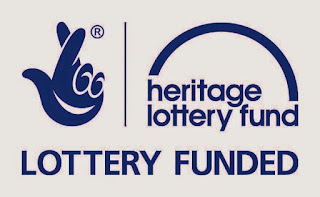The Devonshire Regiment cap badge
Four men from the Lower Otter Valley lost their
lives on 25 September at the Battle of Loos. This was a combined Anglo-French
offensive intended to break through the German defences in
Artois and Champagne in NW France and restore a war of movement.
Image credit: Imperial War Museum ART 1460
The action saw the first British use of poison gas,
with disappointing results. “It will be
seen that the attack with gas was not the success that had been anticipated,”
wrote the Special Correspondent of the Western Morning News of 5 April 1919. “It
lacked the element of surprise as to the exact moment it was to be
launched. A favourable wind was an
important feature in the days when gas clouds were the vogue.”
The 9th followed in support, losing a great many men to machine gun fire as they crossed No Man’s Land to join the 8th in their stretch of German trench. The survivors of the two Battalions held the position until the evening of 26 September, when they were withdrawn.
The two Battalions succeeded in capturing German field guns, two of which were brought back to Exeter to be paraded in the streets.
The Loos Memorial
Image credit: www.cwgc.org
But the ultimate result was a stalemate, with
heavy losses on both sides. In this single battle the 8th Battalion suffered
639 casualties, and the 9th 476.
“We had a
terrible time starting on the 25th September,” wrote Private Dennis in the Western Evening News of 13 November
1915. “We lost over 600 men and all the
officers that went with us. I never felt
more proud of Devonshire men than I do today.
When we were all lined up waiting for the word to charge (of course we
were in the first line of trenches all night, it was 6.20 when we got the order
to charge), not a man failed. When we
got over the parapet we were met with a terrible rifle and shell fire, gas, and
barbed wire. The enemy seemed to know
what we were going to do.”
All four men from the Lower Otter Valley are
commemorated on the Loos Memorial, near the village of Loos-en-Gohelle, five kilometres north-west of
Lens. The Memorial forms the sides and back of Dud Corner Cemetery.
Samuel Keen was born in Cheriton
Fitzpaine in Mid Devon in 1879. He was the son of dairy farmer Samuel senior
and Charlotte Keen, who had seven children.The 1891 census shows the family
living at Brook Farm, Tiverton, but young Samuel later became a waggoner and a
resident of East Budleigh, although his name does not appear on any memorials
in the village. He was 35 years old when he was killed.
The War Memorial in All Saints Church, East Budleigh
Private Arthur Palmer was an East Budleigh man,
born around 1874. He was the son of
Alfred and Mary Jane Palmer and had a brother, William, who would die two years
later, on 23 August 1917. Arthur Palmer
left a widow, Jeanette, but has no known grave. However his name appears on war
memorials in Exmouth and in Seaton as well as on the All Saints Church memorial
in East Budleigh.
Private Charles Stuart’s name
also appears on All Saints
Church memorial, tragically next to those of his two brothers Arthur and Albert,
who were killed in 1916 and 1917 respectively.
All three were the sons of William Henry
and Elizabeth Ann Stuart, of Brookside Cottage. Charles was aged only 20 when
he died.
Twenty-two-year-old Private William West was the
fourth man from the 8th Batallion to be killed in action on 25
September 1915. The 22-year-old was the
sixth of 13 children born to John and Amelia West and grew up in East Budleigh.
His mother’s maiden name was Sanders.
Perriam's grocery store was at 23 Fore Street
By 1911 the family had moved to Budleigh Salterton;
when William died they were living at 12, Cliff Road. His father John was a van man for Perriams, the town’s grocery
store, where William worked as an assistant before he enlisted.
William Henry West’s name appears on Budleigh
Salterton’s War Memorial and on the
brass plaque in St Peter’s Church in Budleigh Salterton, as well as at the town’s
football club, and on the Loos Memorial.
‘The Great War at Fairlynch’ 2015 exhibition at Budleigh Salterton’s very special museum! Reviews included: “Wonderful display on WW1, informative, bright and relevant. Well done!!
‘The Great War at Fairlynch’ 2015 exhibition at Budleigh Salterton’s very special museum! Reviews included: “Wonderful display on WW1, informative, bright and relevant. Well done!!







I really enjoy your blog.
ReplyDeleteMemorial Plaque Wording
Bronze Plaques